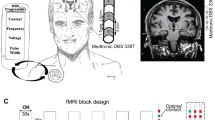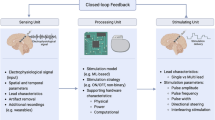Abstract
Purpose
Deep Brain Stimulation (DBS) is a proven therapy for Parkinson’s Disease (PD), frequently resulting in an enhancement of motor function. Nonetheless, several undesirable side effects can occur after DBS, which can worsen the quality of life of the patient. Thus, the clinical team has to carefully select patients on whom to perform DBS. Over the past decade, there have been some attempts to relate pre-operative data and DBS clinical outcomes, with most focused on the motor symptomatology. In this paper, we propose a machine learning-based method able to predict a large number of DBS clinical outcomes for PD.
Methods
We propose a multimodal pipeline, referred to as PassFlow, which predicts 84 clinical post-operative clinical scores. PassFlow is composed of an artificial neural network to compress clinical information, an image processing method from the state-of-the-art to extract morphological biomarkers our of T1 imaging, and an SVM to perform the regressions. We validated PassFlow on 196 PD patients who undergone a DBS.
Results
PassFlow showed correlation coefficients as high as 0.71 and were able to significantly predict 63 out of the 84 scores, outperforming a comparative linear method. The number of metrics that are predicted with this pre-operative information was also found to be correlated with the number of patients with this information available, indicating that the PassFlow method is still actively learning.
Conclusion
We presented a novel, machine learning-based pipeline to predict a variety of post-operative clinical outcomes of DBS for PD patients. PassFlow took into account various bio-markers, arising from different data modalities, showing high correlation coefficients for some scores from pre-operative data only. It indicates that many clinical outcomes of DBS can be predicted agnostic to the specific simulation parameters, as PassFlow has been validated without such stimulation-related information.






Similar content being viewed by others
Availability of data and material
Data is not available for this study.
References
Alexander GE (2004) Biology of parkinson’s disease: pathogenesis and pathophysiology of a multisystem neurodegenerative disorder. Dialogues Clin Neurosci 6(3):259
Kubu CS (2018) The role of a neuropsychologist on a movement disorders deep brain stimulation team. Arch Clin Neuropsychol 33(3):365
Kleiner-Fisman G, Herzog J, Fisman DN, Tamma F, Lyons KE, Pahwa R, Lang AE, Deuschl G (2006) Subthalamic nucleus deep brain stimulation: summary and meta-analysis of outcomes. Mov Disord Off J Mov Disord Soc 21(S14):S290
Tröster AI, Jankovic J, Tagliati M, Peichel D, Okun MS (2017) Neuropsychological outcomes from constant current deep brain stimulation for parkinson’s disease. Mov Disord 32(3):433
Heo JH, Lee KM, Paek SH, Kim MJ, Lee JY, Kim JY, Cho SY, Lim YH, Kim MR, Jeong SY, Jeon BS (2008) The effects of bilateral subthalamic nucleus deep brain stimulation (stn dbs) on cognition in parkinson disease. J Neurol Sci 273(1–2):19
Mugge L, Krafcik B, Pontasch G, Alnemari A, Neimat J, Gaudin D (2019) A review of biomarkers use in parkinson with deep brain stimulation: a successful past promising a bright future. World Neurosurg 123:197
Lang AE, Houeto JL, Krack P, Kubu C, Lyons KE, Moro E, Ondo W, Pahwa R, Poewe W, Tröster AI, Uitti R, Voon V (2006) Deep brain stimulation: preoperative issues. Mov Disord Off J Mov Disord Soc 21(S14):S171
Pollak P (2013) Handbook of clinical neurology, vol 116. Elsevier, Amsterdam, pp 97–105
Rizzone MG, Martone T, Balestrino R, Lopiano L (2019) Genetic background and outcome of deep brain stimulation in parkinson’s disease. Parkinsonism Relat Disord 64:8
Jaggi JL, Umemura A, Hurtig HI, Siderowf AD, Colcher A, Stern MB, Baltuch GH (2004) Bilateral stimulation of the subthalamic nucleus in parkinson’s disease: surgical efficacy and prediction of outcome. Stereotact Funct Neurosurg 82(2–3):104
Farrokhi F, Buchlak QD, Sikora M, Esmaili N, Marsans M, McLeod P, Mark J, Cox E, Bennett C, Carlson J (2020) Investigating risk factors and predicting complications in deep brain stimulation surgery with machine learning algorithms. World Neurosurg 134:e325
Watanabe S, Suenaga K, Yamamoto A, Abe K, Kotoura N, Ishikura R, Hirota S, Yoshikawa H (2012) Correlation of subthalamic nuclei t2 relaxation times with neuropsychological symptoms in patients with parkinson’s disease. J Neurol Sci 315(1–2):96
Lönnfors-Weitzel T, Weitzel T, Slotboom J, Kiefer C, Pollo C, Schüpbach M, Oertel M, Kaelin A, Wiest R (2016) T2-relaxometry predicts outcome of dbs in idiopathic parkinson’s disease. NeuroImage Clin 12:832
Ballarini T, Mueller K, Albrecht F, Ružička F, Bezdicek O, Ružička E, Roth J, Vymazal J, Jech R, Schroeter ML (2019) Regional gray matter changes and age predict individual treatment response in parkinson’s disease. NeuroImage Clin 21:101636
Peralta M, Baxter JSH, Khan AR, Haegelen C, Jannin P (2020) Striatal shape alteration as a staging biomarker for parkinson’s disease. NeuroImage Clin 27:102272
Habets JG, Janssen ML, Duits AA, Sijben LC, Mulders AE, De Greef B, Temel Y, Kuijf ML, Kubben PL, Herff C (2020) Machine learning prediction of motor response after deep brain stimulation in parkinson’s disease-proof of principle in a retrospective cohort. PeerJ 8:e10317
Frizon LA, Hogue O, Achey R, Floden DP, Nagel S, Machado AG, Lobel DA (2019) Quality of life improvement following deep brain stimulation for parkinson disease: development of a prognostic model. Neurosurgery 85(3):343
Shamir RR, Dolber T, Noecker AM, Frankemolle AM, Walter BL, McIntyre CC (2014) A method for predicting the outcomes of combined pharmacologic and deep brain stimulation therapy for parkinson’s disease. In: International conference on medical image computing and computer-assisted intervention pp 188–195
Senders JT, Staples PC, Karhade AV, Zaki MM, Gormley WB, Broekman ML, Smith TR, Arnaout O (2018) Machine learning and neurosurgical outcome prediction: a systematic review. World Neurosurg 109:476
Kostoglou K, Michmizos KP, Stathis P, Sakas D, Nikita KS, Mitsis GD (2016) Classification and prediction of clinical improvement in deep brain stimulation from intraoperative microelectrode recordings. IEEE Trans Biomed Eng 64(5):1123
Collins GS, Reitsma JB, Altman DG, Moons KG (2015) Transparent reporting of a multivariable prediction model for individual prognosis or diagnosis (tripod) the tripod statement. Circulation 131(2):211
Khan AR, Hiebert NM, Vo A, Wang BT, Owen AM, Seergobin KN, MacDonald PA (2019) Biomarkers of parkinson’s disease: Striatal sub-regional structural morphometry and diffusion mri. NeuroImage Clinical 21:101597
Xiao Y, Fonov V, Chakravarty MM, Beriault S, Al Subaie F, Sadikot A, Pike GB, Bertrand G, Collins DL (2017) A dataset of multi-contrast population-averaged brain mri atlases of a parkinson’s disease cohort. Data Brief 12:370
Peralta M, Jannin P, Haegelen C, Baxter JSH (2021) Data imputation and compression for parkinson’s disease clinical questionnaires. Artif Intell Med (in press)
Post B, Merkus MP, de Bie RM, de Haan RJ, Speelman JD (2005) Unified parkinson’s disease rating scale motor examination: are ratings of nurses, residents in neurology, and movement disorders specialists interchangeable? Mov Disord Off J Mov Disord Soc 20(12):1577
Mateen BA, Liley J, Denniston AK, Holmes CC, Vollmer SJ (2020) Improving the quality of machine learning in health applications and clinical research. Nat Mach Intell 2(10):554
Pencina MJ, Goldstein BA, D’Agostino RB (2020) Prediction models-development, evaluation, and clinical application. N Engl J Med 382(17):1583
Vickers AJ, Van Calster B, Steyerberg EW (2016) Net benefit approaches to the evaluation of prediction models, molecular markers, and diagnostic tests. BMJ 352. https://doi.org/10.1136/bmj.i6
Funding
This work was funded by the Fondation pour la Recherche Médicale.
Author information
Authors and Affiliations
Corresponding author
Ethics declarations
Conflict of interest
The authors have no relevant financial or non-financial interests to disclose.
Ethical approval
All procedures performed in studies involving human participants were in accordance with the ethical standards of the institutional and/or national research committee and with the 1964 Helsinki Declaration and its later amendments or comparable ethical standards.
Code availability
Code is currently not made available.
Informed consent
Informed consent was obtained from all individual participants included in the study.
Additional information
Publisher's Note
Springer Nature remains neutral with regard to jurisdictional claims in published maps and institutional affiliations.
Rights and permissions
About this article
Cite this article
Peralta, M., Haegelen, C., Jannin, P. et al. PassFlow: a multimodal workflow for predicting deep brain stimulation outcomes. Int J CARS 16, 1361–1370 (2021). https://doi.org/10.1007/s11548-021-02435-9
Received:
Accepted:
Published:
Issue Date:
DOI: https://doi.org/10.1007/s11548-021-02435-9




